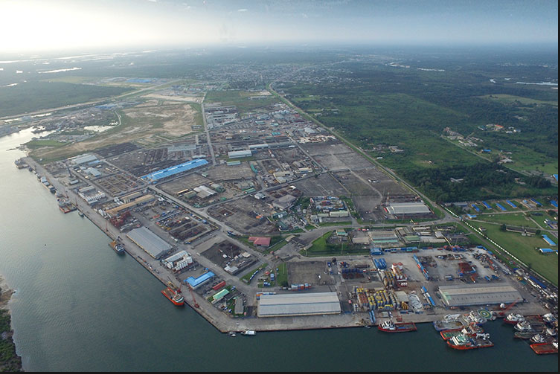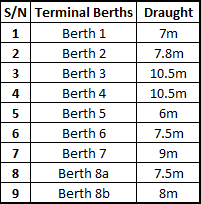- Port Overview
- Port Picture
- Description and Contacts of Key Companies
- Port Performance
- Discharge Rates and Terminal Handling Charges
- Berthing Specifications
- General Cargo Handling Berths
- Port Handling Equipment
- Container Facilities
- Customs Guidance
- Terminal Information
- Stevedoring
- Hinterland Information
- Port Security
Port Overview
Port Harcourt Port is situated off the Gulf of Guinea with a quay length of 1,259 metres and a stacking area of 27,497.15 m2. This port is a multi-purpose facility and is strategically located in one the world’s largest crude oil production regions, the Niger delta. Operators here include the Port and Terminal Operators Limited (PTOL) and BUA Ports and Terminals Nigeria Limited.
The Port is equipped with 16 tanks of 3,048 MT capacity of bulk oil installation and four (4) Arcon sheds with storage capacity 12,486.15m2.
The Port plays the ‘Mother-Port’ role to several jetties surrounding her as ‘satellites’ through the provision of pilotage and towage services, catering for the various markets, relating to Dry, Liquid and General cargo trades.
Port website: http://nigerianports.gov.ng/rivers/
- Ports and Terminal Operators Limited: http://www.ptolnigeria.com/
- BUA Ports and Terminal: https://www.buagroup.com/index.php
Key port information may also be found at: http://www.maritime-database.com
|
Port Location and Contact |
|
|
Country |
Nigeria |
|
Province or District |
Port Harcourt Quays |
|
Nearest Town or City with Distance from Port |
Onne: 22km |
|
Port's Complete Name |
Ports and Terminal Operators Limited |
|
Latitude |
04°46.0' N |
|
Longitude |
007°00.0' E |
|
Managing Company or Port Authority |
Terminal A: PTOL Terminal, Mrs Ada / 08065296305 adaku.jephthah@ptolnigeria.com Terminal B: BUA Ports and Terminal Ltd |
|
Management Contact Person |
See above |
|
Nearest Airport and Airlines with Frequent International Arrivals/Departures |
Port Harcourt International Airport, Omagwa. Arik Air, British Airways,, Emirates, Ethiopian Airlines, Etihad Airways |
Port Picture

Terminal berths

Description and Contacts of Key Companies
Under the NPA concession program, the following operators are responsible for the management, maintenance and operations of its individual terminal.
Terminal services offered by these terminals are containers, multipurpose and bulk.
The terminal operators are
- Ports and Terminal Operators Limited,
- BUA ports and terminals
For more information on port contacts, please see the following link: 4.4 Nigeria Port and Waterways Company Contact List
Port Performance
Terminal A has a total length of about 650 metres straight quay. There is no berth limitation to any vessel calling at Terminal A. The distance from Fairway buoy to Bonny is 17 Nautical miles while Bonny to Port Harcourt is 24 Nautical miles steering 7 Nautical. Fairway Buoy to Port Harcourt Port (Terminal A) is about 6 Hours. The average daft at Terminal A is of 9.5 m while the draft of channel is 12.5m.
There are no major limitations in operating through this port except for periodic route congestions. Average waiting time of vessels alongside terminal is 5 days. Cumulative handling capacity at the Port Harcourt port is 3,462,425 MT (Including container volume).
|
Seasonal Constraints |
||
|
Occurs |
Time Frame |
|
|
Rainy Season |
Yes |
From April to September |
|
Major Import Campaigns |
No |
|
|
Other Comments |
The peak months of the rainy season is between the months of July & August. |
|
|
Handling Figures for 2017 |
|
|
Vessel Calls |
312 vessels |
|
Container Traffic (TEUs) |
192,356 TEUs |
|
Handling Figures Bulk and Break Bulk for 2017 |
|
|
Bulk (MT) |
6,015,080 |
|
Break bulk (MT) |
unconfirmed |
Discharge Rates and Terminal Handling Charges
For information on port rates and charges, please see the following link:
- Ports and Terminal Operating Limited
- BUA Ports and Terminal
Berthing Specifications
|
Type of Berth |
Total Quantity |
Length (m) |
Maximum Draft (m) |
Comments |
|
Conventional Berth |
5+ |
599m |
9m |
- |
|
Container Berth |
4+ |
650m |
10.5 |
- |
|
Silo Berth |
Nil |
Nil |
Nil |
- |
|
Berthing Tugs |
N/A |
- |
- |
Tug boats are allocated to vessels by the Nigeria Port Authorities |
|
Water Barges |
N/A |
- |
- |
Container barges are privately owned and operated. |
General Cargo Handling Berths
|
Cargo Type |
Berth Identification |
|
Imports - Bagged Cargo |
5,6,7,8,8A |
|
Exports - Bagged Cargo |
5,6,7,8,8A |
|
Imports and Exports - RoRo |
RoRo vessels do not call at this port, preference is for Tin Can |
|
Other Imports |
1,2,3,4 |
Port Handling Equipment
Port equipment is privately managed. The respective terminals were all concessioned by the government to private businesses who now operate and manage the port facilities and in turn pay royalties to the government for the period of concession.
|
Equipment |
Available |
Total Quantity and Capacity Available |
Comments on Current Condition and Actual Usage |
|
Dockside Crane |
No |
N/A |
Vessels are expected to be geared. |
|
Container Gantries |
No |
N/A |
Vessels are expected to be geared. |
|
Mobile Cranes |
Yes |
Sufficient for demand |
|
|
Reach stacker |
Yes |
Sufficient for demand |
Available at both terminals |
|
RoRo Tugmaster (with Trailer) |
No |
- |
- |
|
Grain Elevator with Bagging Machines |
No |
N/A |
- |
|
Transtainer |
No |
N/A |
- |
|
Forklifts |
Yes |
Sufficient for demand |
Available at both terminals |
Container Facilities
|
Facilities |
20 ft |
40 ft |
|
Container Facilities Available |
Forklifts, Reach stackers, handlers |
Forklifts, Reach stackers, handlers |
|
Container Freight Station (CFS) |
Yes |
|
|
Refrigerated Container Stations |
Yes |
|
|
Other Capacity Details |
PTOL terminal is the core container terminal here and has been receiving additional shipments diverted by importers from Lagos port, hence strains on yard capacity and equipment. There aren’t any of such issues for BUA which is a core general cargo terminal. |
|
|
Daily Take Off Capacity |
There are no delays as a result of offloading capacity. Container unloading facilities are efficient. |
|
|
Number of Reefer Stations |
100+ |
|
|
Emergency Take-off Capacity |
There are no delays as a result of offloading capacity. Container unloading facilities are efficient. |
|
|
Off take Capacity of Gang Shift |
There are no delays as a result of offloading capacity. Container unloading facilities are efficient. |
|
Customs Guidance
Customs offices are located within the port complex and official office hours are between 0800 and 1700 hours every working week. Customs do not operate weekends or public holidays and may be more difficult to engage on Fridays
For more information on customs in Nigeria, please see the following link: 1.3 Nigeria Customs Information
Terminal Information
Multi-Purpose Terminal
PTOL is predominantly a container terminal and without facilities to handle general cargo vessels.
BUA can handle general cargo and bulk vessels (Frozen fish, Bagged Rice, Bagged cement, Project cargo, Coated steel pipes, etc). They have 2 warehouse facilities within the terminal measuring 4,200m2 total.
Grain and bulk handling
Only BUA terminal is fitted with handling equipment (grabber) to cater for bulk vessels. They have a sucker to cater for Bulk Wheat, Palm Kernel Shell, Bulk Cement etc. They also handle Liquid Bulk Tallow, Crude Palm oil, Base Oil etc.
Main storage terminal
There is sufficient current warehouse space for food stores, bagged and general cargo however not all facilities are totally secure. This should be checked with clearing agents.
BUA has 2 warehouse facilities within the terminal and measuring a total of 4,200m2.
|
Storage Type |
Number of Storage Facilities |
Area (m2) |
|
Bagged Cargo |
2 |
4200 |
|
Refrigerated Cargo |
No |
- |
|
General Cargo |
2 |
12000 |
Stevedoring
Stevedoring services are the sole responsibility of the terminal operators. In addition to in-house stevedores, there are several third-party service providers registered with each terminal and the terminal operators nominate stevedoring companies to handle respective vessels.
Hinterland Information
Almost 100% of import shipments are moved out from the port by road. Goods or containers are loaded on trucks for delivery to destination. Truck ownership here is a combination of terminal and third-party vendors. Only a small percentage of cargo are initially moved using barges to other coastal locations within the city.
Port Security
Both terminals currently operate on ISPS level 1. Access into the terminal is strict with mechanisms put in place by each terminal operator to prevent the entry of un-authorized personnel into the terminal. All authorized persons are provided reflective jackets and head helmets before being allowed access into the terminals.
|
Security |
|
|
ISPS Compliant |
Yes |
|
Current ISPS Level |
Level 1 |
|
Police Boats |
Yes |
|
Fire Engines |
Yes |


